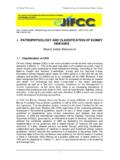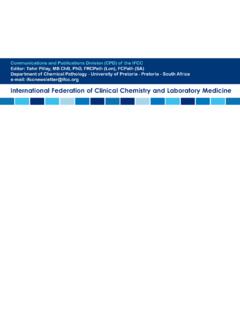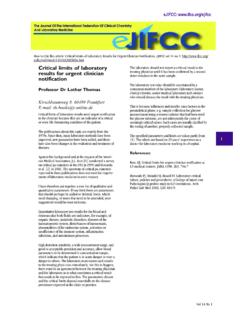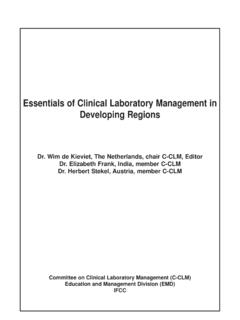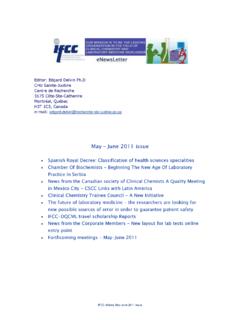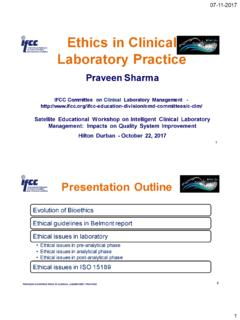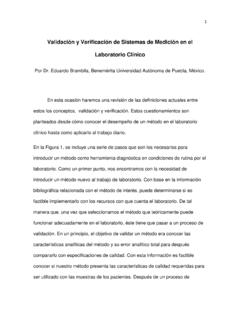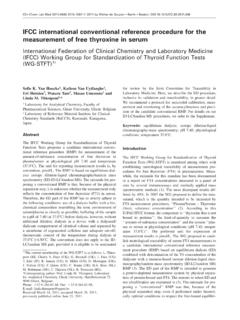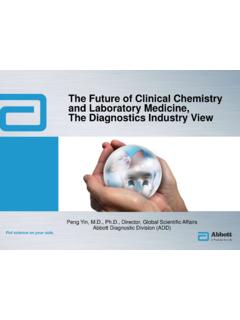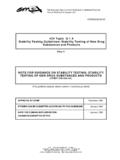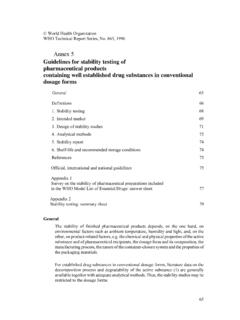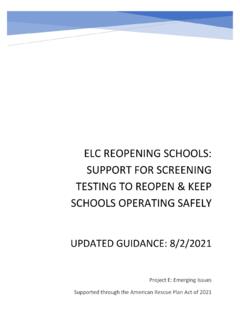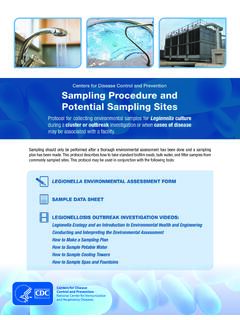Transcription of Quality Requirements of a Point of Care Testing Service
1 1 Quality Requirements of a Point of Care Testing ServiceAdil I. Khan MSc, PhDAssistant Professor of PathologyDirector of Point of Care Testing & Clinical Chemistry Laboratory, Temple University Episcopal Hospital, Philadelphia, PAObjectivesKnow what is meant by Point of Care TestingKnow what is involved in setting up a Point of Care Testing ProgramUnderstand the issues associated with Point of Care Testing23 What is Point of Care Testing ? Point of Care Testing is the Testing of patient samples outsidethe confines of the clinical laboratoryUsually performed by nurses Hospital areas near to the patient (wards, physician offices)4 Point of Care TestingNear patientTestingPeripheralTestingDecentral ized TestingSatelliteTestingBedsideTestingPat ient focusedTestingAncillary TestingSome POCT Function of POC testsTo provide rapid resultsResults should improve immediatepatient management7 Examples of Point of Care TestspHBlood gases.
2 PCO2, pO2 LactateGlucoseHbA1cUrea, creatinineCholesterol, TGsBNP,Troponin, CK-MB,MyoglobinBilirubinPTHD rugs of abuseOccult blood (fecal or gastric)UrinalysishCG, ketones, glucose,Leukocytes, pH, nitrite,Bacterial/viral InfectionsCoagulationHemoglobin/ hematocrit8 Physician performed tests (microscopy)HIV-1/2 testingBlood in feces (fecal-occult blood Testing )Pregnancy Testing for hCGpH Testing Urinalysis using the dipstickBlood glucose by glucose meter9 Blood gasesActivated clotting timeBlood Testing by HpOne10 POCTPOCTPOCTPOCTPOCTPOCTPOCT: ChallengesStaff training and competency maintenance Testing without institutional review or approval Noncompliance with procedures (specimen labeling, QC, proficiency Testing etc.) 11So what does a POC Testing sService need?Good Management TeamGood Training Program12 Management TeamThe first requirement for maintaining Quality in a POC Testing Service is to have a good management team13 Quality STANDARDSESTABLISHESMONITORSENFORCESM anagement TeamAt the bare minimum this team needs: DIRECTOR or equivalent that has the authority to cause institutional change Point -OF-CARE COORDINATOR who is the instrument for implementing that change14 Management Team15 Point -of-Care CoordinatorTogether: advises and resolves problems as they occurDirectorMeets the users dailyRegularly performs audits to assess the Quality of the Service 16 Compliance ReviewWeekly review of POCT test stationsCompliance with written protocol?
3 Corrective action for outlier results?Annual review of user competency (test)17 Non-compliant POCT sitePOC TeamCompliant POCT siteA Good Training ProgramIn a hospital environment healthcare workers that will use Point -of-care tests include: Physicians Registered Nurses Students Nurse aids Licensed practical nurses Respiratory care practitioners Anesthesia technicians Perfusionists Emergency technicians Paramedics18 The Procedure ManualIt is important that POCT users receive the same information regarding the test to ensure consistency of practice:This is the function of the: PROCEDURE MANUAL 19 The Procedure ManualWritten procedures reduce variability, and its variability in test procedures between operators that leads to errors and discrepant manual should not only mention the procedure but should be more Procedure ManualScope (who can perform the test)Principles of the testSpecimen Requirements Reagent/Kit storage conditionsProcedure for performing Quality Control Instrument maintenance (if needed)Procedure for performing the testSafety precautionsTest result interpretationTest limitations / interferencesDocumentation of the test result21 The 3 Stages of a Diagnostic TestA diagnostic test can be divided into three stages.
4 The pre-anlaytical stage analytical stage post analytical stageEach step is susceptible to errors that can significantly affect the should be mentioned in the Procedure Manual 22 Training Users in POC TestingOnce the procedure manual has been created it is necessary that all users have read it and this process should be documented. The salient features for each test need to be understood and demonstrated during training. This would be followed by a competency assessment which would be the exit examination before the healthcare worker can test in of Training: Number of staff requiring training be in the thousands A high turnover rate Nursing staff can be transferred between different departments Poor communication between nursing administration and POC coordinator. 2425 Nurse trainer may not be aware of all the pre-analytical, analytical and post-analytical errors that could occur when using the POC may also be performing the test in a different way that could be prone to a higher error rate.
5 Furthermore, from a regulatory standpoint, the trainer would need to have passed their competencies as well. Peer to Peer TrainingThe Designated TrainerBetter way to train new hiresThis designated trainer would aware of all the issues that could occur with the test and would be up-to-date in their MethodsDirect classroom demonstrations and observationsSupplemented with self-learning , e-learning, lectures via webcam, power Point , and a training kit containing manual, laminated posters/aids and AssessmentThe aim:To ensure healthcare workers can not only generate Quality results consistently from the instrument but can correctly manage them in the decision making process. 28 Assessment in two parts:PRACTICALWRITTEN29 Practical AssessmentDirect observations of patient Testing : Using a specimen (previously analyzed specimen, external proficiency Testing material, Quality control material or calibrator) if applicable include any patient preparation if applicable include any specimen handling and processing30 Practical AssessmentRecording and reporting test applicable, direct observation of instrument maintenance and function of problem solving skills (reviewing temperature and QC logs; knowledge of common error messages; knowing who to contact for help).
6 31 Written AssessmentMultiple Choice type questionsTrue / FalseDetermine what is the pass gradeUsers must reach this satisfactory level in the written Acquaintance with procedure UserUserProcedure ManualProcedure ManualTrainingTrainingTest Test Health care workers Aid agencies Military Civilian volunteers Hands-on Self-directed learning Direct observations Reporting critical DocumentationPOCT Quest for QualityResults from POCT dictate the next step in a diagnostic algorithmErrors in laboratory Testing occur in preanalytical and postanalytical stages also true for POCTThe samerigorous Quality assurance procedures apply as if Testing were performed in the main laboratorySources of Error - PreanalyticalTest orderingPatient identificationSpecimen collection Arterial vs venous vs capillarySpecimen identificationFasting vs non-fastingWrong anticoagulantContamination with IV fluidHemolysisInadequate sample35 Sources of Error - AnalyticalInadequate mixing of sampleAir bubblesEnvironmental conditionsOutdated reagents (deterioration)Instrument failureQC out of limitsInadequate maintenance/calibration36 Sources of Error - PostanalyticalIncorrect reading of resultsResult outside the linear limitNon-recognition of interferencesNo result recordedResult recorded on wrong patient chart3738 Quality Assurance ProgramLaboratory InstrumentPOC instrumentCorrelation studiesExternal Quality Assessment SchemesEQA schemes are very useful in helping to.
7 Identify if healthcare workers are adequately if there are procedural deficiencies mentioned in the product insert but omitted in the final procedural deficiencies not mentioned in the product on EQA ProgramSample provided by College of American Pathologists (CAP)Sample is treated like a patient sampleResults are sent to CAPYour result is compared to others using the same instrumentWhen External Samples are Not AvailablePatient samples can be split and either sent to another instrument or be used by another advantage of using patient samples is that matrix effects are eliminated as real patient samples are being used. 41 Criteria for Split Sample StudiesIt is important to define criteria for acceptability of the sample correlation. This can be obtained from published guidelines or using 2 or 3 standard deviations from the mean from Quality control data for quantitative of known result Point -of-Care TestCorrect Result Not following procedures Preanalytical errors Analytical errors Postanalytical errorsIncorrect ResultRoot Cause Analysis QC material Calibrator Patient Specimen Reference standards Manufactured patient-like sampleTesting process in place produces reliable resultsCORRECTIVE ACTIONS ummary of External Quality Assessment SchemeQuality ControlRunning Quality controls (QC)
8 Is a mandatory requirement for any Point -of-care test because they are designed to detect problems in the test are tested before or alongside a patient test and should always be run according to the manufacturer s instructions in the product insert. Their use monitors test kit and reagent integrity. 44 Quality ControlFor example a QC failure could arise from incorrect storage of kits and/or also be due to poor techniques or procedures. Thus QC gives assurance that the device is working and the Testing is being performed correctly. 45 Quality ControlNon-instrumented qualitative Point -of-care tests such as pregnancy tests, HIV tests, rapid strep A or flu tests typically have two types of controls:Internal controls - built into the test system and are run whenever a patient sample is tested. Confirm that the test system is working, and for lateral flow methods, sufficient specimen has been added to the well to allow the sample to migrate correctly through the ControlExternal controls are run just like a patient sampleThey test the entire Testing process including.
9 Specimen collection Specimen application Result documentation47 ASSESS REGULATORY Requirements THAT NEED TO BE SATISFIEDGATHER INFORMATION ON Point -OF-CARE TEST AND THE Testing PROCESS Pre-analytical steps Analytical steps Post-analytical stepsRISK ASSESSMENT Sampling Errors Operator Errors Errors arising from Environment Errors due to poor reagents/QC/Calibrators Measuring system errorsDEVELOP A Quality CONTROL PLAN TO MITIGATE ERRORSIMPLEMENTATION AND MONITORING OF PLANI ndividual Quality Control PlanDeveloping an IQC PlanAssessing any regulatory or accreditation Requirements that need to be information about the instrument and the Testing process for the analyte (s) from the Assessment - mapping the process to identifying procedural a Quality Control Plan to mitigate errors identified in the risk and monitoring the Quality Control Plan to ensure that it is always appropriate, making adjustments as necessary4950 Stage in which Failure OccursProblemEffectRemedyPrevention MonitorPre analyticalWrong reagent lot usedIncorrect resultRepeat using the correct lotOperator training Audit frequency to target operator for trainingAnalyticalReagents expired Incorrect result or no reactionVerify expiration date/storage conditions.
10 Rerun with non-expired reagentsTrain operator to check dates and label any new expiration date as required by manufacturerAudit reagents to ensure not being used beyond expiration operators trainingPost analyticalNo indication on patient chart that physician was notified of critical or abnormal resultDelayed treatmentGive treatment or retestOperator training on handling critical and abnormal resultsAudit frequency of critical and corresponding notificationFinal Garbage in (PreanalyticalErrors) Garbage out World s best POC Instrument 0 PreanalyticalErrorsTranscription errorWorld s best POC InstrumentResult meaningless Effective monitoring and education essential! Thank You for your Attention!Questions?52
